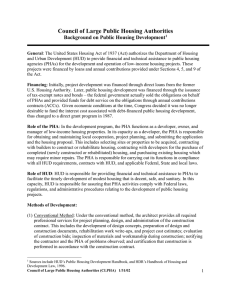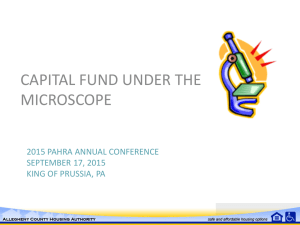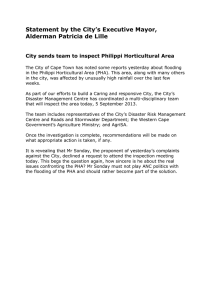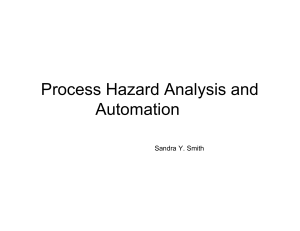PIH 2015-20
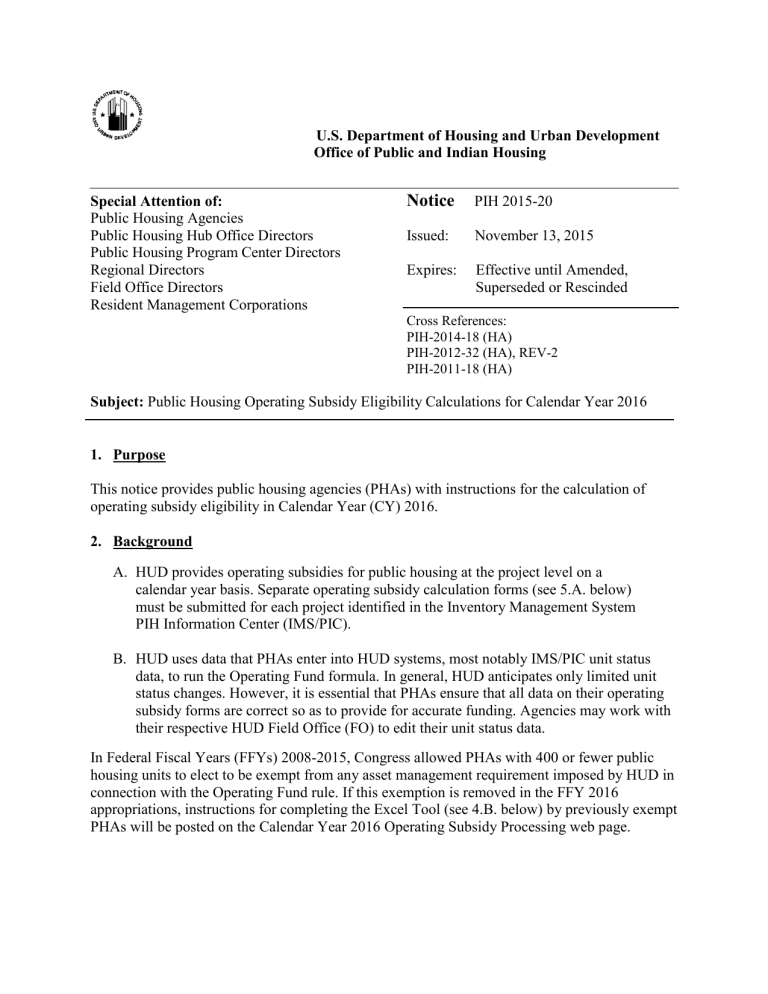
U.S. Department of Housing and Urban Development
Office of Public and Indian Housing
Special Attention of:
Public Housing Agencies
Public Housing Hub Office Directors
Public Housing Program Center Directors
Notice
PIH 2015-20
Issued: November 13, 2015
Regional Directors Expires: Effective until Amended,
Field Office Directors Superseded or Rescinded
Resident Management Corporations
Cross References:
PIH-2014-18 (HA)
PIH-2012-32 (HA), REV-2
PIH-2011-18 (HA)
Subject: Public Housing Operating Subsidy Eligibility Calculations for Calendar Year 2016
1.
Purpose
This notice provides public housing agencies (PHAs) with instructions for the calculation of operating subsidy eligibility in Calendar Year (CY) 2016.
2.
Background
A.
HUD provides operating subsidies for public housing at the project level on a calendar year basis. Separate operating subsidy calculation forms (see 5.A. below) must be submitted for each project identified in the Inventory Management System
PIH Information Center (IMS/PIC).
B.
HUD uses data that PHAs enter into HUD systems, most notably IMS/PIC unit status data, to run the Operating Fund formula. In general, HUD anticipates only limited unit status changes. However, it is essential that PHAs ensure that all data on their operating subsidy forms are correct so as to provide for accurate funding. Agencies may work with their respective HUD Field Office (FO) to edit their unit status data.
In Federal Fiscal Years (FFYs) 2008-2015, Congress allowed PHAs with 400 or fewer public housing units to elect to be exempt from any asset management requirement imposed by HUD in connection with the Operating Fund rule. If this exemption is removed in the FFY 2016 appropriations, instructions for completing the Excel Tool (see 4.B. below) by previously exempt
PHAs will be posted on the Calendar Year 2016 Operating Subsidy Processing web page.
3.
HUD’s Initial Obligation of CY 2016 Operating Subsidy
Based on IMS/PIC building and unit data, HUD will generate and publish an inventory list identifying projects it has determined to be eligible for funding and notify PHAs via the
Financial Management Division (FMD) listserve (PHAs can sign up to receive notification via
FMD’s listserve using the link below). HUD will generate the Operating Fund Calculation electronic forms, HUD-52723 and HUD-52722 (Excel Tools), based on this inventory list. To help ensure that HUD generates Excel Tools for all projects that are eligible for funding, PHAs must contact their respective FO within 10 business days of the list being published to advise
HUD of any errors (eligible projects missing from the list, or ineligible projects on the list).
Projects that are not on the inventory list may not receive funding in the initial obligation of operating subsidy. If HUD generates a Tool for a project that is not eligible, the PHA should not submit that Tool.
2
HUD will publish a document submission schedule on the Calendar Year 2016 Operating
Subsidy Processing web page (see link below). HUD’s initial obligation of operating subsidy funding for CY 2016 may be based on estimates. If a PHA finds that the estimated eligibility does not reflect the project’s actual eligibility for 2016, the PHA should not draw down any excess funds and the PHA should immediately notify the appropriate FO. HUD will recapture any funded amounts for any project deemed ineligible as soon as that determination is made, and for any project that was overfunded, HUD will recapture funds after a final determination of eligibility is made. Details of the methodology used to calculate the estimates will be posted on the Calendar Year 2016 Operating Subsidy Processing web page. Please check this page periodically for any updates on scheduling and initial obligation methodology.
Link to FMD Listserve Signup Web Page http://portal.hud.gov/hudportal/HUD?src=/program_offices/public_indian_housing/programs/ph/am
Link to CY 2016 Operating Subsidy Processing Web Page http://portal.hud.gov/hudportal/HUD?src=/program_offices/public_indian_housing/programs/ph/am/o f/opfnd2016
4. General Operating Subsidy Submission Processing for CY 2016
A. Required Forms and Documentation
For HUD to determine operating subsidy eligibility under the Operating Fund formula,
PHAs must complete and submit the following two forms for each project: i.
Form HUD-52723, Operating Fund Calculation of Operating Subsidy; and ii.
Form HUD-52722, Operating Fund Calculation of Utilities Expense Level.
PHAs must also submit the following forms and documentation, as applicable: i.
Form SF-424, Application for Federal Assistance, is required as part of the government-wide e-grants management initiative (refer to the Calendar Year 2016
Subsidy Processing web page for guidance on completion of this form). Each
PHA shall submit only one form SF-424. PHAs are to send an email to the appropriate FO with the scanned document attached. However, with prior FO approval, the PHA may send it by fax.
PHAs must have a Dun and Bradstreet Universal Identifier Numbering System
(DUNS) number as well as active registration in the System for Award
Management (SAM; www.sam.gov
) to receive funds from HUD’s financial systems. If a PHA does not have a DUNS number, the Calendar Year 2016
Subsidy Processing web page provides directions on how to receive one.
HUD may suspend or not obligate Operating Subsidy grants for PHAs that do not comply with the above requirements. ii.
Form HUD-50071, Certification of Payments to Influence Federal Transactions.
Each PHA shall submit only one form HUD-50071. iii.
Any other supporting documentation requested by the FO.
B. Submission Process
Instructions for completing the CY2016 Operating Fund Calculation electronic forms, HUD-
52723 and HUD-52722 (Excel Tools) and other required forms will be posted on the
Calendar Year 2016 Operating Subsidy Processing web page. Forms must be submitted by email to the local HUD FO. Failure to meet the submission deadline posted on the web site will be interpreted as a rejection of the grant (operating subsidy) by the PHA.
NOTE : PHAs must submit the forms to HUD regardless of whether they are prepared by the
PHA’s fee accountant or any other entity acting on behalf of the PHA. Fee accountants or entities other than the PHA may not submit the forms directly to HUD.
3
C. Pre-populated Data
To reduce PHA reporting burden and in accordance with 24 CFR 990.135(b)(2), information
PHAs have submitted in HUD’s systems of record (including IMS/PIC and the Financial
Assessment Subsystem – Public Housing (FASS-PH)) will be used to pre-populate the CY
2016 Excel Tools.
4
Unit status and other data for the July 1, 2014 through June 30, 2015 reporting period will be extracted from IMS/PIC and summarized at the project level in the CY 2016 Excel Tools.
Asset Repositioning Fee (ARF) eligibility will be determined based upon IMS/PIC data as well. If the pre-populated data is incorrect, entries may be edited by the PHA and/or the FO in accordance with Table 1 below and the instructions that follow.
Table 1: CY 2016 Pre-populated Formula Data
Item Description
Project Number
Name of PHA
Address of PHA
ACC Number
DUNS Number
Total number of ACC units for the PHA
Unit status data: Form HUD-52723, Section 2,
Categorization of Unit Months, Column A,
Lines 01, 02, and 05 through13
*Unit status data: Form HUD-52723,
Section 2, Categorization of Unit Months,
Column A, Lines 03 and 04
Column B, Lines 6a and 17
Per Unit Month (PUM) project expense level (PEL)
PEL inflation factor
Utilities expense level (UEL) inflation factor
Payment in lieu of taxes (PILOT)
Cost of independent audit
Asset Repositioning Fee (ARF). Section
3, Line 14
PUM formula income
Transition funding
PHA Can Edit
Yes
No
No
No
Yes
Yes
Yes
No
No
No
No
Yes
No
No
Yes
No
FO
Can Edit
No
No
No
Yes
Yes
Yes
Yes
Yes
No
No
No
Yes
Yes
Yes
Yes
No
*Note - Unit status data in Section 2, Categorization of Unit Months, Column A, Lines 03 and
04 are new units that are not picked up in the pre-populated reporting data and are editable by the PHA.
5
FO Changes to Categorization of Unit Months pre-populated data.
Appropriate documentation is required to demonstrate that pre-populated IMS/PIC data is incorrect if: i.
for Occupied dwelling unit months (Section 2, Column A, Line 01 of the HUD-
52723), there is an increase of 3% or more from the pre-populated number; or ii.
for Units vacant unit months (Section 2, Column A, Line 11 of the HUD-52723) that are not categorized in section iii below, there is a decrease of 3% or more from the pre-populated number; or iii.
for the aggregate of Lines 02 and 05–12 (excluding Line 11), Section 2, Column
A, of the HUD-52723, there is an increase of 3% or more from the pre-populated number.
This documentation must include, at a minimum: i.
Demonstration that the cause of the data discrepancy was outside the control of the PHA and, ii.
Demonstration that the PHA made timely efforts to resolve the discrepancy (a
Technical Assistance Center (TAC) ticket number is required to demonstrate timely effort).
FOs may request any additional documentation considered necessary.
5. Revisions to CY 2016 Operating Subsidy Eligibility
PHAs may request revisions to their original CY 2016 operating subsidy submissions based on any of the five reasons listed below. All revision requests must be submitted to the appropriate
FO no later than Friday, June 17, 2016, to allow sufficient time for FO review and for the inclusion of any resulting changes to eligibility in the final CY 2016 operating subsidy eligibility prior to the end of FFY 2016.
A.
Correction of mathematical, clerical, information system or other errors;
B.
New projects/units (24 CFR 990.155). (Guidance on funding of new projects/units, i.e., added after the reporting period, is on the Calendar Year 2016 Operating Subsidy
Processing web page);
C.
Approval of demolition or disposition of units (24 CFR 990.155);
D.
New utilities incentives/contracts (24 CFR 990.185); or
6
E.
Appeals submitted in accordance with this notice and approved by HUD (24 CFR
990.245).
New Projects: The final posting of new Project Tools to the Calendar Year 2016 Operating
Subsidy Processing web page normally occurs in the first half of July. After the new Project
Tools are posted, PHAs will be provided a week to complete them and submit them to their FO for processing.
6. Other Operating Subsidy Calculation Information
A.
Project Expense Levels (PELs). PELs for CY 2016 will be based on IMS/PIC project, building and unit characteristics. PELs may change when PHAs regroup their projects.
To estimate the impact of project regroupings, PHAs can use the Project Expense Level
(PEL) Estimator on the Asset Management Project Expense Levels web page at: http://portal.hud.gov/hudportal/HUD?src=/program_offices/public_indian_housing/programs/ph/ am/pels
Changes that become effective after HUD pulls IMS/PIC project, building and unit characteristics for the calculation of PELs for CY 2016, will apply to CY 2017 operating subsidy calculations.
B.
Formula Income. Per unit month ( PUM) formula income will be pre-populated based on the PHA’s most recently approved FY 2014 FASS-PH Financial Data Schedule
(FDS) submissions. Guidance on permitted changes to the pre-populated data, and required supporting documentation that must be submitted when PHAs make changes to the pre-populated data can be found on the CY 2016 Operating Subsidy web page.
Special guidance for capturing the resident-paid utilities incentive in a HUD-approved energy performance contract on Form HUD-52723, Section 3, Part B, Line 01, PUM formula income, is on the Calendar Year 2016 Operating Subsidy Processing web page.
Please see Notice PIH 2014-18 for more information on Rate Reduction Incentives.
Form HUD-52723, Section 3, Par t B, Line 02, “PUM change in utility allowances,” will be locked for data entry. This line has been obsolete since the “unfreezing” of formula income at the end of CY 2009. Changes to utility allowances have been reflected in formula income since the “unfreezing.”
C.
Cost of Independent Audit. Project audit costs will be pre-populated in the Excel
Tool. The pre-populated costs reflect the most recently approved CY 2014 FASS-PH
FDS submissions. If a project’s mo s t recent actual audit cost differs from the amount pre-populated, the PHA should enter the project’s most recent actual audit cost and attach proof of payment to the CY 2016 submission. Independent audit costs are restricted to the audit costs associated with the Operating Fund program and not costs related to non-public housing units in mixed-finance project.
D. Payments in Lieu of Taxes (PILOT). Project PILOT amounts will be pre-populated in the Excel Tool. The pre-populated amounts reflect the most recently approved CY
2014 FASS-PH FDS submissions. If a project’s most recent actual PILOT amount is greater than the amount pre-populated, the PHA may enter the project’s most recent actual PILOT amount and attach proof of payment to the CY 2016 submission.
Twenty-four CFR 990.190(c) provides that “each PHA will receive an amount for PILOT in accordance with section 6(d) of the 1937 Act, based on its cooperation agreement or its latest actual PILOT payment.” Section 6(d) of the 1937 Act specifies that PILOT shall be equal to “10 per centum of the sum of the shelter rents charged in such project, or such lesser amount as (i) is prescribed by State law, or (ii) is agreed to by the local governing body in its agreement for local cooperation with the public housing agency required under section 5(e)(2) of this Act, or (iii) is due to failure of a local public body or bodies other than the public housing agency to perform any obligation under such agreement.”
PILOT is pre-populated in the HUD-52723 form by calculating 10 percent of shelter rents. If one of the lesser amounts identified in (i), (ii) or (iii) above apply, the PHA must overwrite the pre-populated amount with the lesser amount.
7
E. Asset Management Fee. i.
PHAs with 250 or more units (400 or more units under the asset management exemption appropriations provisions) must comply with asset management requirements under 24 CFR 990.255 through 990.290, Subpart H -- Asset
Management. Form HUD-52574, PHA Board Resolution, includes a certification that all statutory and regulatory requirements have been met. PHAs not in compliance will forfeit the asset management fee pursuant to 24 CFR 990.190(f).
In determining compliance with asset management, FOs will review the PHA’s most recent financial submission approved by HUD, and other relevant material. ii.
For PHAs that are in compliance with the regulatory asset management requirements: (1) PHAs with at least 250 units are eligible for a $4 PUM asset management fee; and (2) PHAs with fewer than 250 units that elect to transition to asset management are eligible for a $2 PUM asset management fee. PHAs with only one project regardless of the number of units are not eligible for an asset management fee pursuant to 24 CFR 990.190(f). iii.
Even if a PHA has opted out of asset management, it must continue to request operating subsidy for each project show n in IMS/PIC (i.e., not all projects combined into one) on the date HUD pulls project, building and unit data (see 8.A. above).
F. Asset Repositioning Fee (ARF). i.
PHAs must follow the requirements in 24 CFR 990.190(h) and Notice PIH 2011-
18, “Guidance on the Asset-Repositioning Fee Under 24 CFR 990.190(h) and
Guidance on Re-occupying Public Housing Units Proposed or Approved for
Demolition, Disposition, or Transition to Homeownership.”
8 ii.
When a unit becomes eligible for ARF, it is no longer eligible for other operating subsidy. Where a unit is eligible for ARF, PHAs must remove any unit months used to calculate ARF from Section 2 of the HUD-52723, except Column A,
Line 12 as noted below. After ARF eligibility ends, if the units have not yet been removed from the ACC, they must be reported in Column A, Line 13. iii.
PHAs shall submit supporting documentation detailing the ARF calculation for the requested amount. Supporting documentation must include:
1.
The project number;
2.
Identification of the buildings and units approved for demo/dispo/homeownership;
3.
Approval date of the demo/dispo application or homeownership plan, whichever is applicable;
4.
Date of the first day of the next quarter six months after the date the first unit becomes vacant after the relocation date included in the approved relocation plan;
5.
ARF unit months for the project or building(s);
6.
PEL in effect the first year of ARF funding and the PEL percentage (75% PEL per unit for the first twelve months, 50% PEL per unit for the next twelve months, or 25% PEL per unit for the next twelve months, as per 24 CFR
990.190(h)(3));
7.
Relocation date as defined in Notice PIH 2011-18, which must be consistent with
End Of Participations (EOPs) in IMS/PIC; and
8.
A statement as to whether or not all units were vacant at the time of the demo/dispo/homeownership plan approval.
FOs may request other relevant information as necessary. iv. HUD-52723 submissions must include the number of unit months associated with the ARF on Section 2, Line 12, provided that these unit months may only be for units that have not yet been removed from inventory and therefore remain on the
ACC. The ARF unit months must be reported on Line 12 may be different than those used to calculate ARF eligibility as reflected in Section 3, Part A, Line 14.
This is because unit months used to calculate ARF eligibility are not required to be on the ACC. iv.
ARF requests that do not include all of the items listed above and any other items requested by the FO will not be eligible for subsidy.
G.
UEL and Central Office Cost Center (COCC). COCC utility consumption and costs are not included in the calculation of the PHA’s/project’s UEL on form HUD-52722.
If the COCC is located within a project, actual consumption, including the rolling base consumption, and utility costs for the COCC must be excluded from the UEL calculation for the project. PHAs must explain the methodology used to calculate the excluded COCC data (e.g., square footage) in Section 10, Remarks, of the form.
Special guidance for excluding COCC utility consumption and costs from combined consumption and costs in a pre-asset management Energy Performance Contract is on the Calendar Year 2016 Subsidy Processing web page.
9
PHAs are reminded that if they dispose or demolish projects or entire buildings within a project they shall exclude all data by utility (rate, consumption, rolling base, eligible unit months, etc.) for these projects or buildings once the actual consumption (see Line 01) for the 12-month period ending June 30 th
that is 6 months prior to the first day of the funding period no longer contains a full 12 months (including no months) of consumption for these projects or buildings. The PHA also shall make an adjustment to the rolling base.
PHAs shall provide HUD additional details (i.e., amounts, calculation and methodology) regarding this adjustment in the remarks section of this form or as a separate attachment.
The UEL on Line 26 of the HUD-52722 must be used to populate Section 3, Part A, Line
5 of the HUD-52723. In addition, Section 2 Column B, Lines 04, 15, and 17 of the HUD-
52723 must be used to calculate Line 25 of the HUD-52722. Funding may be suspended for projects where the two forms are not consistent with each other.
H.
Elderly/Disabled Service Coordinator Program. For CY 2016, the public housing share of the reasonable cost of salary, fringe benefits and administrative costs for the
Elderly/Disabled Service Coordinator (EDSC) program is eligible for operating subsidies. Only PHAs previously receiving EDSC funding (not Resident Opportunities and Self-Sufficiency [ROSS] funding for service coordinators that serve elderly/disabled residents) are eligible. Eligibility may be confirmed on the Calendar
Year 2016 Operating Subsidy Processing web page.
Total EDSC eligibility may only increase annually up to the amount of the annual inflation factor on form HUD-52723, Section 3, Part A, Line 02. Eligible PHAs may enter the eligibility amount for the EDSC program on form HUD-52723, Section 3,
Part A, Line 07. This "Self-sufficiency" line is restricted to the EDSC program and does not include ROSS funding.
I.
Environmental Requirements i.
As noted in the Operating Subsidy rule at 24 CFR 990.116, the environmental review procedures of the National Environmental Policy Act of 1969 (42 U.S.C.
4332(2)(C)) and the implementing regulations at 24 CFR parts 50 and 58 are applicable to the Operating Fund Program.
10
J. Moving-to-Work (MTW) PHAs. i. MTW PHAs with an alternative Operating Fund formula agreement shall submit operating subsidy forms in accordance with their MTW Agreement. Generally, this involves submitting one set of forms on a PHA-level basis. Where the MTW agreement indicates the submission of one set of forms, the PHA shall use the Excel
Tools as noted below. Where more than one set of forms is required, the PHA shall follow requirements in Attachment A and 24 CFR 990 as directed by HUD.
1.
HUD-52723: Enter Sections 1; Section 3, Part C, Lines 01 and 04; and Part
D, Lines 01 and 03; and,
2.
HUD-52722: Enter data in accordance with the MTW agreement.
3.
MTW PHAs with alternative Operating Fund formula agreements shall submit documentation showing and supporting the agreement’s formula as an attachment to the HUD-52723 (which may include forms and unit months referenced in Attachment A of their MTW Agreement). ii. MTW PHAs not using an alternative Operating Fund formula will have their electronic form pre-populated as regular formula PHAs, and shall complete and submit all sections of the form HUD-52723 and the form HUD-52722 on a project-level basis using the electronic forms and requirements under the regular program.
7. Appeals
A. Types of Appeals. 24 CFR 990.245 establishes five types of appeals: i.
Streamlined appeal: This appeal requires the PHA to demonstrate a blatant and objective flaw in the application of a specific Operating Fund formula component. For example, a geographic coefficient is identified with Springfield,
IL, when it should be Springfield, MA. ii.
Appeal of formula income for economic hardship: This appeal is no longer applicable since the frozen formula income provisions of 24 CFR 990.195 expired at the end of 2009. iii.
Appeal for specific local conditions: This appeal requires the PHA to demonstrate that the model-generated project expense levels (PELs) fail to reflect specific local conditions. To be eligible, the affected PHA must demonstrate, by means of an independent cost assessment, that the modelgenerated PEL is not accurate for comparable properties in the PHA’s market area, with a variance of ten percent or greater.
iv.
Appeal for changing market conditions: A PHA may appeal to receive operating subsidy for vacant units due to changing market conditions after the PHA has taken aggressive marketing and outreach measures to rent these units. The vacancies cannot be the result of action or inaction by PHA management. For example, a
PHA located in an area experiencing extreme population loss or economic dislocations may have a shortage of applicants, even with aggressive marketing and outreach. v.
Appeal to substitute actual project cost data: A PHA may appeal PELs based on actual project cost data under an asset management period of at least two years as outlined in 24 CFR 990 Subpart H – Asset Management. For this type of appeal, the PHA must also submit an independent cost assessment.
Notwithstanding the foregoing, nothing in this notice is meant to prevent a PHA from corresponding with the Assistant Secretary, Director of the Public Housing Financial
Management Division, their respective FO Director, or other PIH staff, if appropriate, regarding any issues or concerns regarding notice implementation and operating subsidy eligibility.
B. Appeal Requirements
Pursuant to 24 CFR 990.240, appeals are voluntary and cover the PHA’s entire portfolio, not single projects. The Assistant Secretary for Public and Indian Housing
(PIH), however, has the discretion to accept appeals of less than an entire portfolio for
PHAs with greater than 5,000 public housing units. All other appeals must be based on an impact that affects the entire PHA, not an impact to a single project or set of projects, and any appeals that address single projects and not the entire portfolio will be denied.
For “specific local conditions” and “substitute actual project cost data” appeals, the
PHA is to acquire, at its own expense, an independent cost assessment on each public housing project. The assessor must have appropriate knowledge of multifamily operating costs within the local market. The independent cost assessment includes: i.
Comparable Data: Cited data must be verifiable by HUD with complete source identification. Itemized comparative data must include: locality, occupancy type, building type and PELs. (Refer to Public and Indian Housing
PIC Development Submodule User Manual , pages 4 – 7, for definitions of building types). ii.
Adjustments: Assessments must fully disclose any adjustments made to the comparative data, including the nature of the adjustment, the reason for the adjustment, the adjustment method and citation of source documents.
11
iii.
Reporting: Assessments must present the entire PHA’s portfolio in a table format and include the following for each individual project:
1) Number of units;
2) Occupancy type;
3) Building type;
4) Current PEL; and
5)
Appellant’s suggested PEL.
12
Additionally, the PHA should include a table that presents the recommended unit-weighted average PEL for the entire public housing portfolio as compared with the unit-weighted average PEL assigned by HUD. iv.
For “local conditions” appeals, the appeal must include items i, ii and iii above for independent cost assessments and:
1) Comparable data showing that costs are greater at comparable affordable housing properties in the local area. v.
For “actual project cost data” appeals, the appeal must include items i, ii and iii above for independent cost assessments and:
2) Two years of actual project cost data, showing that PHA costs are not greater than costs at comparable public housing properties; and
3) Documentation certifying the PHA has completed transition to asset management pursuant to 24 CFR 990.290.
C. Processing Requirements for CY 2016
PHA appeals for “changing market conditions” are to be submitted to the appropriate
FO along with the PHA’s original operating subsidy submission for CY 2016.
For “streamlined” appeals, the PHA must describe the flaw and submit supporting documentation. For “local conditions” and “actual project cost data” appeals, the PHA must include the independent cost assessment with its submission. “Streamlined,” “local conditions,” and “actual project cost data” must be sent by email to
William.G.Jones@hud.gov
and Kevin.J.Gallagher@hud.gov
with the subject line “Appeal under 24 CFR 990.245.” Appeals must be sent at the same time that the PHA’s original operating subsidy submission for CY 2016 is sent to the appropriate FO. The PHA also must provide a copy of the appeal to the Public Housing Director of the FO, and the appropriate Financial Analyst at the FO.
Final appeal decisions will be issued within 120 days of PHA submission to HUD
Headquarters. If an appeal is granted, HUD adjusts the PHA’s subsidy by the appropriate amount retroactive to the beginning of the year.
13
8. Turnkey III Projects
A PHA requesting operating subsidy for a Turnkey III project must complete and submit form HUD-53087 , “ Calculation of Subsidies for Operations: Non-Rental Housing.” The operating subsidy provided to a Mutual Help or Turnkey III project is partially based on the project’s operating budget. Entries on the HUD-53087 must be based on the appropriate line items from the latest approved operating budget at the time of the CY 2016 submission, and sent to the appropriate FO.
9.
Rental Assistance Demonstration
A PHA that has applied for participation in the Rental Assistance Demonstration (RAD) will still complete its CY 2016 subsidy submission in accordance with the instructions in this notice until its RAD transaction is closed for the project(s) in question. Public housing projects will be processed in accordance with this notice and 24 CFR 990 until the end of the year in which their HAP Contract becomes effective. Any projects that are selected and convert in 2016, i.e., execute a Section 8 Housing Assistance Payment Contract, will terminate their participation in the public housing program in accordance with RAD program instructions. (For further information on the RAD, see Notice PIH 2012-32, Rental
Assistance Demonstration – Implementation Revision 2, June 15, 2015.)
10. PHA Board Resolution
The PHA Board Resolution (form HUD-52574) approving the PHA’s operating budget must be submitted to the appropriate FO prior to the beginning of the PHA’s fiscal year.
Only one Board Resolution needs to be submitted per PHA, regardless of the number of projects. If the PHA has more than one project, insert the phrase “for all projects” in the first checkbox description. The checkbox then will read “Operating Budget for all projects approved by Board resolution on:” (date).
11.
HUD Approval of Calculations
HUD will post on the Calendar Year 2016 Operating Subsidy Processing web page an explanation of its funding methodology and the obligation letters for each set of interim months funded. Based on the FFY 2016 Appropriations Act, PHA operating subsidy eligibility submissions, and FO reviews, HUD will determine and approve final operating subsidy levels for CY 2016. . Final subsidy levels for PHAs will be posted on the same web page.
12.
Penalty for false claims and statements
HUD will prosecute false claims and statements. Such false statements and/or entries may be subject to criminal and/or civil penalties (18 U.S.C. 1001, 1010, 1012; 31 U.S.C. 3729,
3802).
13.
Further Information
All questions from PHAs are to be referred to the appropriate FO.
14
14. Paperwork Reduction Act
The information collection requirements contained in this notice have been approved by the
Office of Management and Budget under the Paperwork Reduction Act of 1995 (44
U.S.C.3520) and assigned OMB approval numbers 2577-0026, 2577-0029, 2577-0157 and
2577-0246. In accordance with the Paperwork Reduction Act, HUD may not conduct or sponsor, and a person is not required to respond to, a collection of information unless the collection displays a currently valid OMB number.
____________/s/_________________
Lourdes Castro Ramírez
Principal Deputy Assistant Secretary
for Public and Indian Housing
